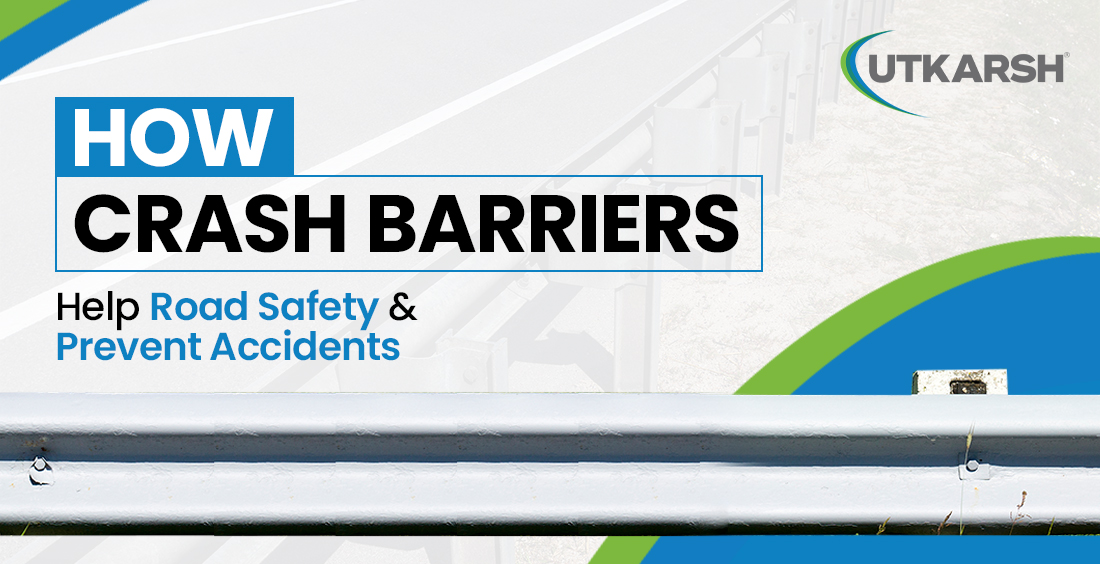How Crash Barriers Help Road Safety and Prevent Accidents

All road users look forward to a safe journey, but some unpredictable situations such as a change in lanes, tire bursting, or wet roads might suddenly become dangerous. Therefore, crash barriers on roads are absolutely necessary on the roads. Understanding how crash barriers help road safety provides us information on how crash barriers help in saving lives. Bridges, and sharp curve roads have crash barriers that help decrease the rate of collision which guides the vehicles towards the correct path while preventing serious accidents from becoming deadly.
What Is Crash Barrier?
Before discussing in depth, it's essential to answer a basic but important question—what is crash barrier?
A Crash barrier is a form of protective structure which is placed along roads, highways and mediнахs to hold or slow down vehicles during an accident. These barriers are made of steel, concrete, or even plastic and are placed on critical zones. Their main aim is to put off the energy that is getting discharged while crashing into the walls.
Types of Crash Barriers on Roads
Different situations call for different types of crash barriers on roads. Each type is engineered for specific conditions and impact levels.
Rigid Barriers (Concrete Barriers): These are fixed structures that don’t move during a collision. They're often seen on expressways or bridge edges. Although they don’t absorb much energy, they redirect vehicles effectively to prevent head-on collisions or rollovers.
Semi-Rigid Barriers (W-Beam, Thrie-Beam): These are made of galvanized steel and offer a balance between flexibility and strength. They bend slightly during an impact, absorbing part of the energy and pushing the vehicle back onto the road.
Flexible Barriers (Wire Rope Barriers): Used in areas where visibility and flexibility are crucial, these are composed of steel cables that absorb a significant amount of energy by stretching during a crash. They're cost-effective and quick to install.
Each of these designs plays a unique role in improving road safety barriers on different kinds of roads and terrains.
Click here to know more: 6 Essential Facts About W Beam Crash Barriers | Utkarsh India
How Crash Barriers Help Road Safety
Knowing how crash barriers help road safety means understanding the exact functions they serve beyond just being roadside installations.
Prevents Vehicle Run-Offs: One of the primary functions of a crash barrier is to prevent vehicles from leaving the roadway, especially in areas where steep slopes, rivers, or cliffs are nearby. Without these barriers, even a minor loss of control can become fatal.
Reduces Severity of Accidents: By absorbing impact or redirecting the vehicle's path, crash barriers on roads reduce the force that hits passengers. This plays a major role in lowering fatalities and critical injuries.
Protects Pedestrians and Property: In urban settings, road safety barriers also shield pedestrians, cyclists, and property from out-of-control vehicles. In high-traffic zones or near schools and parks, these barriers create a layer of defense.
Guides Traffic Flow: Properly placed crash barriers on roads also serve as visual guides, especially on curves, construction zones, or during poor visibility conditions. They inform drivers about road limits and help avoid confusion or panic.
Prevents Head-On Collisions: On divided highways, road safety barriers placed in the median can stop a vehicle from jumping into the opposite lane, thus preventing head-on crashes—a major cause of fatalities.
Strategic Placement of Road Safety Barriers
It’s not just about having barriers—it’s about placing them where they matter most. Areas that need crash barriers include:
Sharp bends and hairpin curves
Bridge approaches and embankments
Toll plazas and tunnel entrances
School zones and pedestrian-heavy areas
Steep drops or mountainous roads
Placing crash barriers on roads in these critical areas significantly cuts down accident severity and keeps the transportation ecosystem secure.
Know What Are the Advantages of Using Metal Crash Barriers Over Concrete Ones?
Final Thoughts
Knowing what a crash barrier is and how crash barriers help road safety gives a real sense of the quiet yet essential role they serve in everyday travel. These aren't just steel structures or concrete blocks—they're reliable lifesavers built to withstand impact and reduce harm. With smart engineering, regular innovation, and strategic placement, crash barriers on roads will remain a key factor in keeping people safe.
Being a leading manufacturer of Metal Beam Crash Barriers, we offer a trusted range of crash-tested products including W-Beam, Thrie Beam, and Pedestrian Guard Rails—crafted using premium materials like galvanised steel to meet global safety standards.
Whether you're a policymaker, engineer, or just a daily commuter, recognizing the value of road safety barriers leads to better decisions and stronger support for safer roads ahead.
FAQs:
What is the most common barrier used on the road?
The most common barrier used on the road is the W-Beam crash barrier, made of galvanized steel, known for its durability and effective impact absorption.
What do all crash barriers have in common?
All crash barriers are designed to absorb impact, redirect vehicles, and reduce the severity of accidents, enhancing overall road safety.
Which safety feature is most likely to prevent a crash?
The most effective safety feature to prevent a crash is Electronic Stability Control (ESC), as it helps maintain vehicle control during sudden maneuvers or slippery conditions.